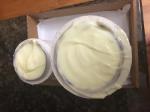Chamomile Essential Oil
Chamomile essential oil, used to consist of two main types...Roman Chamomile and German Chamomile. Today there are many different Chamomile essential oils to choose from but they all share one characteristic....azulene.
Some of the links on this site are affiliate links. If you buy a product through them, I receive a small commission which helps me provide the free information you find on this site. Thank you for your support!
Azulene is a powerful anti-inflammatory with skin healing properties. It is found in the form of blue crystals in the oil. The darker blue the oil, the more Azulene the oil contains.
Common Name: Chamomile
Botanical Name: Matricaria chamomilla (German); Anthemis nobilis (Roman); plus various other types.
INCI Name: Matricaria chamomilla (chamomile) oil; Anthemis nobilis flower oil; plus various other types.
Common Extraction Method: Steam distillation of the flowers.
Plant Origin: Major producers include USA, Hungary, Egypt, United Kingdom, Morocco, Nepal, South Africa, Italy and France.
Physical Description: Can range anywhere from a pale clear yellow color to a deep dark blue. The oils consistency also ranges from a thin liquid in the lighter oils to a medium liquid in the darker oils.
Aromatic Description: The scents range from medium to strong in strength and depending on the type can have a straw-like odor, fruity apple-like odor, or a warm spicy herbaceous odor.
Properties & Benefits: Has anti-bacterial, anti-depressant, anti-inflammatory, anti-microbial, anti-septic, batericidal and nerve sedative properties. It's skin care benefits include helping to relieve acne, allergies, boils, burns, cuts, dermatitis, eczema, inflammation, insect bites and rashes. It's aromatic benefits include it's ability to help to relieve headaches, insomnia, migraines, nervous tension and other stress related complaints.
Blends well with: Bergamot, lavender, geranium, sage, tea tree, jasmine, grapefruit, ylang ylang, lemon, neroli, rose and oakmoss.
Cautions: Non-toxic but can cause dermatitis in some individuals.
This information is provided for reference use only and is not meant to substitute the advice of a licensed health care professional.



Facebook Comments